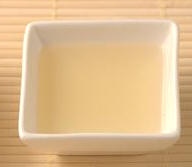Mirin
Culinary uses for mirin plus recipes using mirin

What is Mirin?
Mirin is a type of Japanese rice wine, similar to Sake but nowhere near not as
strong, and with a light syrupy texture. The alcohol content depends on the type
you buy and ranges from under 1% to around 14%. It is likely that the type
available at your local supermarket will be almost non-alcoholic however the
delectable nectar sweet smooth taste will more or less be the same as an
alcoholic version. Mirin is a key ingredient in Japanese cuisine however it can
also be used in western cooking as exampled below.
Â
How to use Mirin?
Outside of Japan Mirin is probably best known as one of the main ingredients in
Teriyaki sauce, however there are many other occasion where mirin can be used to
enhance the flavour or appearance of foods. Here are some ideas on how to use
Mirin:-
Â
 |
As a natural balancer to soy sauce, mirin can be
used in most dishes which also use soy sauce.
 |
 |
Sherry Substitute:Â Where recipes call for a
small quantity of sherry, mirin make a good substitute.
 |
 |
As a seasoning: Mirin can also be used (together
with salt and rice vinegar) to season sushi rice where it also gives the
rice an extra gloss. They can also be mixed with other ingredients to glaze
grilled or baked meat, poultry, fish and vegetables.
 |
 |
In dips and dressings: Mirin is often included in
dips for tempura and can be added to many western type salad dressings for a
touch of sweetness.
 |
 |
Stir-frying: Mirin is perfect for stir-fried
dishes and goes especially well with vegetables, pork, noodles and fish stir
fries.
 |
 |
In marinades: Apart from adding extra flavour,
Mirin makes certain foods such as tofu firmer which helps it maintain its
texture.
 |
 |
Simmering: Mirin can be used to and depth and
flavour to oriental style simmered and poached dishes particular fish and
tofu dishes.
 |
 |
Sauces: A few dashes of mirin in western style
sauces, in particular BBQ types or gravies gives them a lift.
 |
 |
Desserts and cakes: The sweetness of Mirin makes
it a natural addition to sweet dishes such as cakes and desserts. Add small
amounts to cake batters, glazes and poached fruit. |
|
|